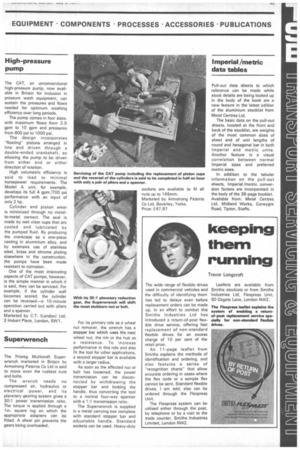High-pressure pump
Page 95

If you've noticed an error in this article please click here to report it so we can fix it.
The CAT, an unconventional high-pressure pump, now available in Britain for inclusion in pressure wash equipment, can sustain the pressures and flows needed for optimum washing efficiency over long periods.
The pump comes in four sizes, with maximum flows from 2.5 gpm to 10 gpm and pressures from 600 psi to 1000 psi.
The design incorporates "floating" pistons arranged in line and driven through a double-ended crankshaft, so allowing the pump to be driven from either end or either direction of rotation.
High volumetric efficiency is said to lead to minimal horsepower requirements. The Model A unit, for example, develops its full 4 gpm /700 psi performance with an input of only 2 hp.
Cylinder and piston wear is minimized through no metalto-metal contact. The seal is made by wet viton cups that are cooled and lubricated by the pumped fluid. By producing the crankcase as a one-piece casting in aluminium alloy, and by extensive use of stainless steel, brass and chrome plating elsewhere in the construction, the pumps have been made resistant to corrosion.
One of the most interesting aspects of CAT pumps, however, is the simple manner in which it is said, they can be serviced. For example, if the cylinder wall becomes scored, the cylinder can be reversed—a 10-minute operation carried out with pliers and a spanner.
Marketed by C.T. (London) Ltd, 3 Hobart Place, London, SW1.












































































































































